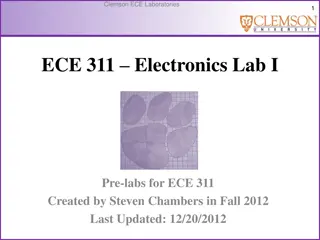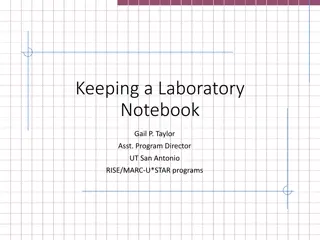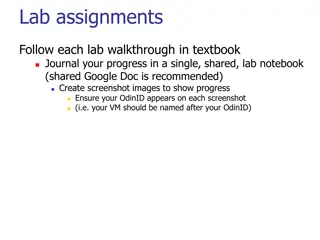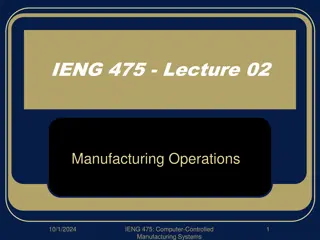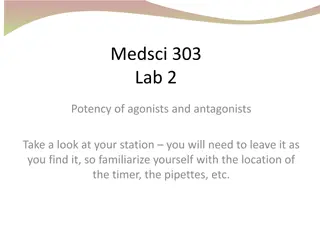Electronics Lab Notebook
This electronics lab notebook contains experiments on resistor variability, reading and sorting resistors, and series resistors. The observations and findings from each lab activity are detailed, providing valuable insights into practical electronics testing and measurement techniques.
Download Presentation

Please find below an Image/Link to download the presentation.
The content on the website is provided AS IS for your information and personal use only. It may not be sold, licensed, or shared on other websites without obtaining consent from the author.If you encounter any issues during the download, it is possible that the publisher has removed the file from their server.
You are allowed to download the files provided on this website for personal or commercial use, subject to the condition that they are used lawfully. All files are the property of their respective owners.
The content on the website is provided AS IS for your information and personal use only. It may not be sold, licensed, or shared on other websites without obtaining consent from the author.
E N D
Presentation Transcript
Electronics Lab Notebook Cohlten Green
Lab 1- Resistor Variability Measured Values Sample 1 2 3 4 5 6 7 8 9 0.98 Measured Values 1 0.98 0.98 0.98 0.98 1.01 1.005 1 1 0.98 0.99 0.98 0.98 0.98 0.99 0.995 10 11 12 13 14 15 16 17 18 19 20 0.99 0.985 1 0.98 0.99 0.98 0.98 0.98 1.01 0.98 0.975 0.97 0.965 1 2 3 4 5 6 7 8 9 10 11 12 13 14 15 16 17 18 19 20 Standard Deviation: 0.009403247 Sample
Lab 1 Observations This lab was to practice measuring resistors to make sure they were good based on their readings and tolerance. All of the resistors that we measured were in the range of being acceptable.
Lab 2- Reading and Sorting Resistors Number Tolerance ( 5% ) Measured High Low Too High TRUE TRUE TRUE TRUE TRUE TRUE TRUE TRUE TRUE TRUE TRUE TRUE FALSE FALSE FALSE Too Low TRUE TRUE TRUE TRUE TRUE TRUE TRUE TRUE TRUE TRUE FALSE TRUE TRUE TRUE TRUE OK? OK OK OK OK OK OK OK OK OK OK OK OK OK OK OK Resistor (ohms) 100 220 330 470 1000 2200 3300 4700 10000 22000 33000 47000 100000 1000000 10000000 0.05 0.05 0.05 0.05 0.05 0.05 0.05 0.05 0.05 0.05 0.05 0.05 0.05 0.05 0.05 98.07 216.08 322.21 463 976 2155 3287 4600 9878 21609 32958 45890 993600 9824000 99500000 105 231 95 209 346.5 493.5 1050 2310 3465 4935 10500 23100 34650 49350 105000 1050000 10500000 313.5 446.5 950 2090 3135 4465 9500 20900 313350 44650 95000 950000 9500000
Lab 2 Observations Lab 2 was to practice reading the color bands on resistors and measuring them afterwards to make sure we were correct. This lab resembles the first lab but now that we know how to measure them and use their tolerances, we can now apply that knowledge with reading other resisters without measuring them but by simple looking at them.
Lab 3 R1 R2 R3 RT Measured Values 9.7k 2.19k 4.6k 16.49k Calculated 10k 2.2k 4.7k 16.9k simulated 10k 2.2k 4.7k 16.9k IT V1 VA VB Measured Value 0.545 9.1 3.76 2.56 Calculated 0.532 9 3.6708 2.5004 simulated 0.533 9 3.675 2.503
Lab 3 Observations Lab 3 was used to teach a few things. One was to begin using Multisim. Another was to begin building circuits physically. The last was measuring nodal voltages, the resistances, and current within the circuit. There were a few problems with making the circuits physically because I didn t understand how the wires and resistors should have been placed. After understanding that, the measuring of the circuit was quite simple. All of the readings came out right because we checked the resistors before hand to make sure they were good. We also compared our physical results with the results from the Multisim tests.
Lab 4 Observations Observations: In order to meet the requirement of 10.000 mA we used the formula, V/I=R, to find the total resistance. Then came up with resistor amounts that, when added up, equaled 900 ohms. This allowed us to meet all the requirements presented in the problem.
Lab 6 Observations We used ohms law to figure out what we needed within the black box. Using the formula to find the totals allowed us to achieve 18mA. Since this circuit was in parallel, we needed to watch how we added our resistors and how the voltage works since the voltage in parallel circuits stay the same throughout.
Lab 7 Observations The multimeter that we used to measure the currents, for each resistor, has too small of a scale to read the current s low readings.
Lab 8- Black Box Design 3 Series and Parallel Mixed
Lab 8 Observations The 5K Ohm pot was difficult to use at first because it was very different than anything we have used before. But the resistor proved to be valuable because you can adjust its resistance without needing to get another resistor to replace it. By adjusting the resistance of the 5k Ohm pot, we were able to meet the requirements in the end of the lab.
Lab 9 Observations This lab introduced mixed circuits or series and parallel. By starting from the right and going to the left to add the resistors, we were able to figure out the total resistance of the circuit. We experimented and tried other ways of adding them together but we couldn t get the right result. So by trying other ways, we confirmed to ourselves that there isn t any other way to get the right answer other than from starting from the right and working our way to the left.
Lab 10 Observations This lab introduced capacitors and how to add and measure them. Capacitors are a little different when adding them together compared to resistors. When capacitors are in parallel, you can simply add there resistances together and get the total. If they are in series, you must put them all under one and then add them together. After that, you must then divide one by the previous total. That gives you the total resistance.
Lab 11 Observations This lab was a little difficult because when we measured using the ohmmeter, we sometimes wouldn t get the right numbers even though everything was connected right and we were measuring right. The oscilloscope was getting the right measurements though. We both thought that the oscilloscope was easy to use once we knew what everything did.
Lab 12 Observations This lab introduced inductors in series and parallel. Getting their totals, like find the total resistance in a series resistor circuit, was quite easy because you can simple add each of the their values together to get their total. They are similar to resistor circuits in that aspect. They follow the same rules with parallel circuits as resistor parallel circuits as well.
Lab 13 Observations This lab had the same issues as lab 11 with measuring with the ohmmeter. We would sometimes get the right values but for the most part, we had to read the values only from the oscilloscope.













